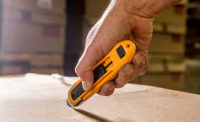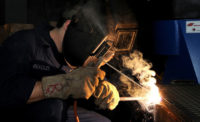Welding is an essential part of numerous manufacturing and assembly processes, employing more than 400,000 people in the United States alone. Because of the nature of the job — working with high temperatures and molten metals — injuries are likely. Personal protective equipment (PPE) can help reduce the risk of on-the-job injuries or accidents in the welding industry.
Here is your ultimate welding safety guide to welding PPE so you can stay safe on the job. All welders must understand how to protect themselves from the hazards their workplace can bring.
Common welding safety hazards
Understanding the common risks you might face in the workplace is vital. According to information collected by OSHA, these dangers include:
- Exposure to metal fumes
- Exposure to ultraviolet radiation
- Burns
- Arc flashes
- Explosions
- Eye damage
- Electrical shock
- Cuts and lacerations
- Crushed fingers or toes
The risks also vary depending on the type of welding. Stick welding is popular because it produces the best-looking welds, but it also has many moving parts, meaning the risk increases. It has an accident rate three times higher than MIG or TIG welding. Underwater welding can be even more dangerous.
Protecting hands
Even under the best circumstances, welding jobs require proximity to high temperatures and molten metals. Human skin isn’t meant to withstand those conditions, so protection is essential. Opt for gloves that are comfortable to work in for extended periods. Cut-resistant versions are helpful, as are welding gloves made from natural or artificial material, designed to protect you from the searing heat.
Protecting skin
Your hands aren’t the only body part that needs protection from heat and errant sparks of molten metal. Opt for densely woven fabrics made from cotton or wool, preferably treated with flame-retardant chemicals. Standard wool or cotton can be flammable, and artificial materials like polyester or acrylic are made of plastic and can melt to the skin if they catch on fire.
If a complete outfit of flame-retardant clothing isn’t an option, consider a welding jacket or apron to protect your wardrobe from the brunt of the molten metal sparks. This can make a huge difference in worker safety.
Protecting eyes and face
The eyes are an essential part of a welder’s craft, but they are also one of the most vulnerable parts of the human body. Eye protection is necessary to protect the eyes from any debris. Exposure to concentrated UV light acts like a sunburn on the cornea. These flash burns are painful and can take several days to heal. Any hair on your head or face could also represent an ignition point that needs protection.
A welder’s helmet and mask can accomplish both these tasks, keeping the UV light from the weld point from damaging your eyes while protecting your head and facial hair from flying sparks or droplets of molten metal.
Protecting feet
As with any industrial setting, proper footwear is essential to any head-to-toe welding PPE build. Ensure you’re wearing high-top, close-toed shoes, preferably made of leather, to offer additional fire retardant properties. You may also wish to wear welding spats or heat-resistant coverings to protect the lower half of your body from molten metal and falling objects.
Steel-toed boots can add an extra layer of protection if you’re prone to dropping heavy things on your toes, but they aren’t strictly necessary. Consider them a bonus.
Protecting hearing
Welding isn’t an industry you generally associate with noise, but hearing protection is required if it generates sounds louder than 85 decibels. Listening to levels this high for more than eight hours at a time can cause progressive hearing loss. The longer you listen or the louder the sounds, the greater the risk. Each 3 dBA rise in volume cuts the safe listening time in half, so you're down to two hours by the time you reach 91 dBA.
The easiest way to protect hearing and prevent work-related hearing loss is to wear properly fitted protection. Ear muffs or headphones are standard, but if they don’t fit under your welding helmet, earplug options can accomplish the same task by cutting down the noise you hear.
Protecting respiratory systems
Welding fumes are usually made up of a mixture of silicates, fluorides and metal oxides, atomized by the welding process and cast into the atmosphere. The last place you want these fumes to end up is in your lungs. Overexposure to welding fumes can damage the lungs, liver, kidneys and bones, up to and including some varieties of cancer. Occupational lung disease and lung cancer are the most common ailments associated with welding fume exposure.
If you’re working with iron or steel, an N95 mask is often more than enough to keep you from inhaling the fumes and particles that could cause respiratory damage. For other metals, upgrading to an N95 respirator or an N99 mask is recommended.
The ozone generated by arc welding requires a more complex respirator to ensure you’re not inhaling all these fumes. Manual ventilation practices can also help remove fumes from your welding space.
Protecting everyone else
You aren’t the only one at risk when welding. Anyone in your immediate vicinity could catch some stray sparks or breath in lungfuls of fumes.
Your welding safety guide should include the installation of booths with fume hoods or other manual ventilation tools. They should be made of noncombustible materials that protect against UV light. If it’s designed properly, it should safeguard anyone working adjacent to the welding project, with only a minimal need for additional PPE.
Only people properly outfitted in welding PPE should be allowed into the booth while a job is underway. Introducing welding booths helps prevent any collateral damage and injuries to people walking by.
Create a welding safety guide that includes welding PPE
By its very nature, welding can be one of the most dangerous jobs — but it doesn’t have to be. Wearing proper welding PPE and creating a welding safety guide can help prevent many of these injuries and make your workplace safer. Accidents aren’t always preventable, but it is possible to mitigate the damage.




